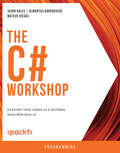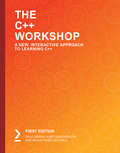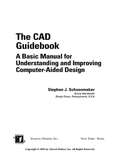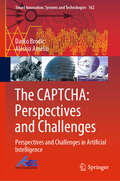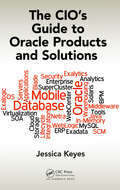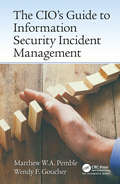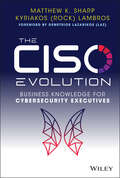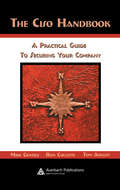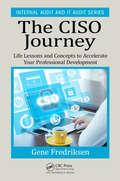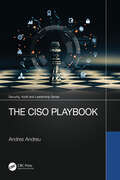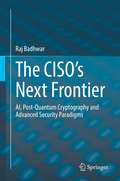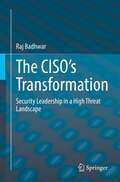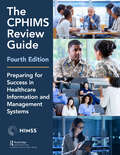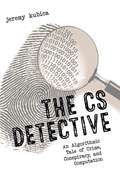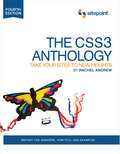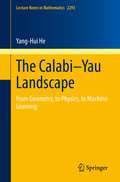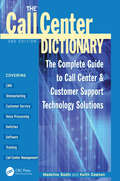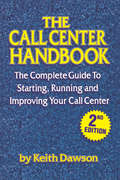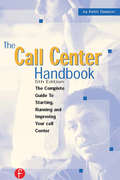- Table View
- List View
The C# Workshop: Kickstart your career as a software developer with C#
by Jason Hales Almantas Karpavicius Mateus ViegasBuild your understanding and confidence with this hands-on guide to programming with C# 10 and .NET 6Key FeaturesGain a solid foundation in C# and focus on coding real-world applicationsLearn how to write clean, effective code and think like a C# developerBuild your experience and confidence with hands-on exercises and activitiesBook DescriptionC# is a powerful, versatile language that can unlock a variety of career paths. But, as with any programming language, learning C# can be a challenging process. With a wide range of different resources available, it's difficult to know where to start.That's where The C# Workshop comes in. Written and reviewed by industry experts, it provides a fast-paced, supportive learning experience that will quickly get you writing C# code and building applications. Unlike other software development books that focus on dry, technical explanations of the underlying theory, this Workshop cuts through the noise and uses engaging examples to help you understand how each concept is applied in the real world.As you work through the book, you'll tackle realistic exercises that simulate the type of problems that software developers work on every day. These mini-projects include building a random-number guessing game, using the publisher-subscriber model to design a web file downloader, creating a to-do list using Razor Pages, generating images from the Fibonacci sequence using async/await tasks, and developing a temperature unit conversion app which you will then deploy to a production server.By the end of this book, you'll have the knowledge, skills, and confidence to advance your career and tackle your own ambitious projects with C#.What you will learnUnderstand the fundamentals of programming with C# 10 and .NET 6Build your familiarity with .NET CLI and Visual Studio CodeMaster the fundamentals of object-oriented programming (OOP)Understand and implement concurrency to write more efficient codeCreate a database and handle data using C#, SQL, and Entity FrameworkBuild web applications using the ASP.NET frameworkRun automated unit tests with NUnit to validate your codeUse principles including SOLID, KISS, ACID, DRY, and design patternsWho this book is forThis book is for aspiring C# developers. It is recommended that you already have a basic understanding of core programming concepts before you start. Prior experience of another programming language would be beneficial, though it is not absolutely necessary.
The C++ Workshop: A New, Interactive Approach to Learning C++
by Dale Green Kurt Guntheroth Shaun Ross MitchellCut through the noise and get real results with a step-by-step approach to learning C++ development Key Features Ideal for the C++ beginner who is getting started for the first time A C++ tutorial with step-by-step exercises and activities that help build key skills Structured to let you progress at your own pace, on your own terms Use your physical print copy to redeem free access to the online interactive edition Book Description You already know you want to learn C++ development, and a smarter way to learn C++ 11 is to learn by doing. The C++ Workshop focuses on building up your practical skills so that you can develop high-performance software applications or even your own independent games with effective modern C++. You'll learn from real examples that lead to real results. Throughout The C++ Workshop, you'll take an engaging step-by-step approach to understanding C++ code. You won't have to sit through any unnecessary theory. If you're short on time you can jump into a single exercise each day or spend an entire weekend learning about advanced object-oriented principles. It's your choice. Learning on your terms, you'll build up and reinforce key skills in a way that feels rewarding. Every physical print copy of The C++ Workshop unlocks access to the interactive edition. With videos detailing all exercises and activities, you'll always have a guided solution. You can also benchmark yourself against assessments, track progress, and receive content updates. You'll even earn a secure credential that you can share and verify online upon completion. It's a premium learning experience that's included with your printed copy. To redeem, follow the instructions located at the start of your C++ book. Fast-paced and direct, The C++ Workshop is the ideal companion for C++ beginners. You'll build and iterate on your code like a software developer, learning along the way. This process means that you'll find that your new skills stick, embedded as best practice. A solid foundation for the years ahead. What you will learn Get to grips with fundamental concepts and conventions of C++ 11 Learn about best practices for clean code and how to avoid common pitfalls Reuse and reduce common code using the C++ standard library Debug and compile logical errors and handle exceptions in your programs Who this book is for Our goal at Packt is to help you be successful, in whatever it is you choose to do. The C++ Workshop is an ideal C++ tutorial for the C++ beginner who is just getting started. Pick up a Workshop today, and let Packt help you develop skills that stick with you for life.
The CAD Guidebook: A Basic Manual for Understanding and Improving Computer-Aided Design
by Stephen J. SchoonmakerCovering how to implement, execute, adjust, and administer CAD systems, The CAD Guidebook presents fundamental principles and theories in the function, application, management, and design of 2- and 3-D CAD systems. It illustrates troubleshooting procedures and control techniques for enhanced system operation and development and includes an extensiv
The CAHIMS Review Guide: Preparing for Success in Healthcare Information and Management Systems (HIMSS Book Series)
by HIMSSHIMSS’ Certified Associate in Healthcare Information and Management Systems (CAHIMS) certification offers a pathway to careers in health information technology (health IT) for associate-level, emerging professionals, or those who would like to transition to health IT from other industries. The CAHIMS Review Guide, 2nd Edition is the ideal resource for those preparing for the CAHIMS certification exam—or looking for a comprehensive "health IT 101" guide. Content in this updated and revised CAHIMS review guide reflects the new CAHIMS exam content outline. Content is divided into three topic categories: organizational and technology environments; systems analysis, design, selection, implementation, support, maintenance, testing, evaluation, privacy, and security; and leadership and management support. Each chapter includes learning objectives for tracking progress in understanding and articulating the content. Practice exam questions at the end of the book reinforce key concepts explored throughout the book. This book is a comprehensive and timely introduction to healthcare information and management systems. It’s also an invaluable resource for staying current in all aspects of the industry. In addition to sample exam questions, this book includes an overview of the eligibility requirements, testing procedures, and the CAHIMS examination itself.
The CAPTCHA: Perspectives and Challenges in Artificial Intelligence (Smart Innovation, Systems and Technologies #162)
by Darko Brodić Alessia AmelioThis book discusses the CAPTCHA (completely automated public Turing test to tell computers and humans apart), an artificial-intelligence-based test commonly used on websites for preventing security attacks, covering its foundations, the main trends and challenges, as well as innovative features and research aspects. It focuses on the recently proposed CAPTCHAs, introducing research approaches for analyzing of the usability of the CAPTCHA test for Internet users. The book enables readers to become familiar with the CAPTCHA technology from the user’s perspective, from the basic concepts underlying the test to more advanced concepts. It is intended for students as well as graduates wanting to gain insights into new CAPTCHA designs as well as new research directions.
The CIO's Guide to Oracle Products and Solutions
by Jessica KeyesFrom operating systems to the cloud, Oracle's products and services are everywhere, and it has the market share to prove it. Given the share diversity of the Oracle product line, and the level of complexity of integration, management can be quite a daunting task.The CIO's Guide to Oracle Products and Solutions is the go-to guide for all things Orac
The CIO’s Guide to Information Security Incident Management
by Matthew William Pemble Wendy Fiona GoucherThis book will help IT and business operations managers who have been tasked with addressing security issues. It provides a solid understanding of security incident response and detailed guidance in the setting up and running of specialist incident management teams. Having an incident response plan is required for compliance with government regulations, industry standards such as PCI DSS, and certifications such as ISO 27001. This book will help organizations meet those compliance requirements.
The CIO’s Guide to Risk
by Jessica KeyesIn an age of globalization, widely distributed systems, and rapidly advancing technological change, IT professionals and their managers must understand that risk is ever present. The key to project success is to identify risk and subsequently deal with it. The CIO’s Guide to Risk addresses the many faces of risk, whether it be in systems development, adoption of bleeding edge tech, the push for innovation, and even the march toward all things social media. Risk management planning, risk identification, qualitative and quantitative risk analysis, contingency planning, and risk monitoring and control are all addressed on a macro as well as micro level. The book begins with a big-picture view of analyzing technology trends to evaluate risk. It shows how to conceptualize trends, analyze their effect on infrastructure, develop metrics to measure success, and assess risk in adapting new technology. The book takes an in-depth look at project-related risks. It explains the fundamentals of project management and how project management relates to systems development and technology implementation. Techniques for analyzing project risk include brainstorming, the Delphi technique, assumption analysis, and decision analysis. Metrics to track and control project risks include the Balance Scorecard, project monitoring and reporting, and business and technology metrics. The book also takes an in-depth look at the role of knowledge management and innovation management in identifying, assessing, and managing risk. The book concludes with an executive’s guide to the legal and privacy issues related to risk management, as well overviews of risks associated with social media and mobile environments. With its checklists, templates, and worksheets, the book is an indispensable reference on risk and information technology.
The CISO Evolution: Business Knowledge for Cybersecurity Executives
by Matthew K. Sharp Kyriakos LambrosLearn to effectively deliver business aligned cybersecurity outcomes In The CISO Evolution: Business Knowledge for Cybersecurity Executives, information security experts Matthew K. Sharp and Kyriakos “Rock” Lambros deliver an insightful and practical resource to help cybersecurity professionals develop the skills they need to effectively communicate with senior management and boards. They assert business aligned cybersecurity is crucial and demonstrate how business acumen is being put into action to deliver meaningful business outcomes. The authors use illustrative stories to show professionals how to establish an executive presence and avoid the most common pitfalls experienced by technology experts when speaking and presenting to executives. The book will show you how to: Inspire trust in senior business leaders by properly aligning and setting expectations around risk appetite and capital allocation Properly characterize the indispensable role of cybersecurity in your company’s overall strategic plan Acquire the necessary funding and resources for your company’s cybersecurity program and avoid the stress and anxiety that comes with underfunding Perfect for security and risk professionals, IT auditors, and risk managers looking for effective strategies to communicate cybersecurity concepts and ideas to business professionals without a background in technology. The CISO Evolution is also a must-read resource for business executives, managers, and leaders hoping to improve the quality of dialogue with their cybersecurity leaders.
The CISO Handbook: A Practical Guide to Securing Your Company
by Michael Gentile Ron Collette Thomas D. AugustTruly a practical work, this handbook offers a comprehensive roadmap for designing and implementing an effective information security program based on real world scenarios. It builds a bridge between high-level theory and practical execution by illustrating solutions to practical issues often overlooked by theoretical texts. This leads to a set of practices that security professionals can use every day. The framework it describes can be expanded or contracted to meet the needs of almost any organization. A reference as well as a guide, each of the chapters are self-contained and can be read in any order.
The CISO Journey: Life Lessons and Concepts to Accelerate Your Professional Development (Internal Audit and IT Audit)
by Eugene M FredriksenThe book takes readers though a series of security and risk discussions based on real-life experiences. While the experience story may not be technical, it will relate specifically to a value or skill critical to being a successful CISO. The core content is organized into ten major chapters, each relating to a "Rule of Information Security" developed through a career of real life experiences. The elements are selected to accelerate the development of CISO skills critical to success. Each segments clearly calls out lessons learned and skills to be developed. The last segment of the book addresses presenting security to senior execs and board members, and provides sample content and materials.
The CISO Playbook (ISSN)
by Andres AndreuA CISO is the ultimate guardian of an organization's digital assets. As a cybersecurity leader ,a CISO must possess a unique balance of executive leadership, technical knowledge, strategic vision, and effective communication skills. The ever-evolving cyberthreat landscape demands a resilient, proactive approach coupled with a keen ability to anticipate attack angles and implement protective security mechanisms. Simultaneously, a cybersecurity leader must navigate the complexities of balancing security requirements with business objectives, fostering a culture of cybersecurity awareness, and ensuring compliance with regulatory frameworks.The CISO Playbook aims to provide nothing but real-world advice and perspectives to both up-and-coming cybersecurity leaders as well as existing ones looking to grow. The book does not approach cybersecurity leadership from the perspective of the academic, or what it should be, but more from that which it really is. Moreover, it focuses on the many things a cybersecurity leader needs to “be” given that the role is dynamic and ever-evolving, requiring a high level of adaptability.A CISO's career is touched from many differing angles, by many different people and roles. A healthy selection of these entities, from executive recruiters to salespeople to venture capitalists, is included to provide real-world value to the reader. To augment these, the book covers many areas that a cybersecurity leader needs to understand, from the pre-interview stage to the first quarter and from security operations to the softer skills such as storytelling and communications.The book wraps up with a focus on techniques and knowledge areas, such as financial literacy, that are essential for a CISO to be effective. Other important areas, such as understanding the adversaries' mindset and self-preservation, are covered as well. A credo is provided as an example of the documented commitment a cybersecurity leader must make and remain true to.
The CISO’s Next Frontier: AI, Post-Quantum Cryptography and Advanced Security Paradigms
by Raj BadhwarThis book provides an advanced understanding of cyber threats as well as the risks companies are facing. It includes a detailed analysis of many technologies and approaches important to decreasing, mitigating or remediating those threats and risks. Cyber security technologies discussed in this book are futuristic and current. Advanced security topics such as secure remote work, data security, network security, application and device security, cloud security, and cyber risk and privacy are presented in this book. At the end of every chapter, an evaluation of the topic from a CISO’s perspective is provided. This book also addresses quantum computing, artificial intelligence and machine learning for cyber securityThe opening chapters describe the power and danger of quantum computing, proposing two solutions for protection from probable quantum computer attacks: the tactical enhancement of existing algorithms to make them quantum-resistant, and the strategic implementation of quantum-safe algorithms and cryptosystems. The following chapters make the case for using supervised and unsupervised AI/ML to develop predictive, prescriptive, cognitive and auto-reactive threat detection, mitigation, and remediation capabilities against advanced attacks perpetrated by sophisticated threat actors, APT and polymorphic/metamorphic malware.CISOs must be concerned about current on-going sophisticated cyber-attacks, and can address them with advanced security measures. The latter half of this book discusses some current sophisticated cyber-attacks and available protective measures enabled by the advancement of cybersecurity capabilities in various IT domains. Chapters 6-10 discuss secure remote work; chapters 11-17, advanced data security paradigms; chapters 18-28, Network Security; chapters 29-35, application and device security; chapters 36-39, Cloud security; and chapters 40-46 organizational cyber risk measurement and event probability.Security and IT engineers, administrators and developers, CIOs, CTOs, CISOs, and CFOs will want to purchase this book. Risk personnel, CROs, IT and Security Auditors as well as security researchers and journalists will also find this useful.
The CISO’s Transformation: Security Leadership in a High Threat Landscape
by Raj BadhwarThe first section of this book addresses the evolution of CISO (chief information security officer) leadership, with the most mature CISOs combining strong business and technical leadership skills. CISOs can now add significant value when they possess an advanced understanding of cutting-edge security technologies to address the risks from the nearly universal operational dependence of enterprises on the cloud, the Internet, hybrid networks, and third-party technologies demonstrated in this book. In our new cyber threat-saturated world, CISOs have begun to show their market value. Wall Street is more likely to reward companies with good cybersecurity track records with higher stock valuations. To ensure that security is always a foremost concern in business decisions, CISOs should have a seat on corporate boards, and CISOs should be involved from beginning to end in the process of adopting enterprise technologies.The second and third sections of this book focus on building strong security teams, and exercising prudence in cybersecurity. CISOs can foster cultures of respect through careful consideration of the biases inherent in the socio-linguistic frameworks shaping our workplace language and through the cultivation of cyber exceptionalism. CISOs should leave no stone unturned in seeking out people with unique abilities, skills, and experience, and encourage career planning and development, in order to build and retain a strong talent pool. The lessons of the breach of physical security at the US Capitol, the hack back trend, and CISO legal liability stemming from network and data breaches all reveal the importance of good judgment and the necessity of taking proactive stances on preventative measures. This book will target security and IT engineers, administrators and developers, CIOs, CTOs, CISOs, and CFOs. Risk personnel, CROs, IT, security auditors and security researchers will also find this book useful.
The CPHIMS Review Guide, 4th Edition: Preparing for Success in Healthcare Information and Management Systems (HIMSS Book Series)
by Healthcare Information & Management Systems Society (HIMSS)Whether you’re taking the CPHIMS exam or simply want the most current and comprehensive overview in healthcare information and management systems today, this completely revised and updated fourth edition has it all. But for those preparing for the CPHIMS exam, this book is also an ideal study partner. The content reflects the outline of exam topics covering healthcare and technology environments; clinical informatics; analysis, design, selection, implementation, support, maintenance, testing, evaluation, privacy and security; and management and leadership. Candidates can challenge themselves with the sample multiple-choice questions given at the end of the book. The benefits of CPHIMS certification are broad and far-reaching. Certification is a process that is embraced in many industries, including healthcare information and technology. CPHIMS is recognized as the ‘gold standard’ in healthcare IT because it is developed by HIMSS, has a global focus and is valued by clinicians and non-clinicians, management and staff positions and technical and nontechnical individuals. Certification, specifically CPHIMS certification, provides a means by which employers can evaluate potential new hires, analyze job performance, evaluate employees, market IT services and motivate employees to enhance their skills and knowledge. Certification also provides employers with the evidence that the certificate holders have demonstrated an established level of job-related knowledge, skills and abilities and are competent practitioners of healthcare IT.
The CS Detective: An Algorithmic Tale of Crime, Conspiracy, and Computation
by Jeremy KubicaMeet Frank Runtime. Disgraced ex-detective. Hard-boiled private eye. Search expert.When a robbery hits police headquarters, it’s up to Frank Runtime and his extensive search skills to catch the culprits. In this detective story, you’ll learn how to use algorithmic tools to solve the case. Runtime scours smugglers’ boats with binary search, tails spies with a search tree, escapes a prison with depth-first search, and picks locks with priority queues. Joined by know-it-all rookie Officer Notation and inept tag-along Socks, he follows a series of leads in a best-first search that unravels a deep conspiracy. Each chapter introduces a thrilling twist matched with a new algorithmic concept, ending with a technical recap.Perfect for computer science students and amateur sleuths alike, The CS Detective adds an entertaining twist to learning algorithms.Follow Frank’s mission and learn:–The algorithms behind best-first and depth-first search, iterative deepening, parallelizing, binary search, and more–Basic computational concepts like strings, arrays, stacks, and queues–How to adapt search algorithms to unusual data structures–The most efficient algorithms to use in a given situation, and when to apply common-sense heuristic methods
The CSS3 Anthology: Take Your Sites to New Heights
by Rachel AndrewThe CSS Anthology: 101 Essential Tips, Tricks & Hacks is a compilation of best-practice solutions to the most challenging CSS problems. The fourth edition of this best-selling book has been completely revised and updated to cover newer techniques enabled by CSS3 and HTML5, and more recent trends in web design, such as responsive design. It is the most complete question-and-answer book on CSS available, with over 100 tutorials that show readers how to gain more control over the appearance of their web pages, create sophisticated web page navigation controls, and design for alternative browsing devices, including phones and screen readers. The CSS code used to create each of the components is available for download and guaranteed to be simple, efficient and cross-browser compatible.
The Calabi–Yau Landscape: From Geometry, to Physics, to Machine Learning (Lecture Notes in Mathematics #2293)
by Yang-Hui HeCan artificial intelligence learn mathematics? The question is at the heart of this original monograph bringing together theoretical physics, modern geometry, and data science. The study of Calabi–Yau manifolds lies at an exciting intersection between physics and mathematics. Recently, there has been much activity in applying machine learning to solve otherwise intractable problems, to conjecture new formulae, or to understand the underlying structure of mathematics. In this book, insights from string and quantum field theory are combined with powerful techniques from complex and algebraic geometry, then translated into algorithms with the ultimate aim of deriving new information about Calabi–Yau manifolds. While the motivation comes from mathematical physics, the techniques are purely mathematical and the theme is that of explicit calculations. The reader is guided through the theory and provided with explicit computer code in standard software such as SageMath, Python and Mathematica to gain hands-on experience in applications of artificial intelligence to geometry. Driven by data and written in an informal style, The Calabi–Yau Landscape makes cutting-edge topics in mathematical physics, geometry and machine learning readily accessible to graduate students and beyond. The overriding ambition is to introduce some modern mathematics to the physicist, some modern physics to the mathematician, and machine learning to both.
The Call Center Dictionary: The Complete Guide to Call Center and Customer Support Technology Solutions
by Madeline BodinCall centres have become the crucial front line for managing customer relationships. This book covers a range of call center terminology. It explains relevant terms, and provides the call center manager with a quick reference that covers the technology and operational issues that come up in running and improving a call center.
The Call Center Handbook
by Keith DawsonThis book is for people who work in a call center and common traits the call center location must offer. It contains practical observations about how to use particular technologies, and ideas about how to run the call center, which has become its own corporate discipline.
The Call Center Handbook: The Complete Guide to Starting, Running, and Improving Your Call Center
by Keith DawsonNeed to know how to buy a phone switch for your call center? How to measure the productivity of agents? How to choose from two cities that both want your center? No problem. The Call Center Handbook is a complete guide to starting, running, and im
The Cambridge Handbook of Artificial Intelligence
by Keith Frankish William M. RamseyArtificial intelligence, or AI, is a cross-disciplinary approach to understanding, modeling, and creating intelligence of various forms. It is a critical branch of cognitive science, and its influence is increasingly being felt in other areas, including the humanities. AI applications are transforming the way we interact with each other and with our environment, and work in artificially modeling intelligence is offering new insights into the human mind and revealing new forms mentality can take. <P> This volume of original essays presents the state of the art in AI, surveying the foundations of the discipline, major theories of mental architecture, the principal areas of research, and extensions of AI such as artificial life. With a focus on theory rather than technical and applied issues, the volume will be valuable not only to people working in AI, but also to those in other disciplines wanting an authoritative and up-to-date introduction to the field.
The Cambridge Handbook of English Corpus Linguistics
by Douglas Biber Randi Reppen Biber, Douglas and Reppen, RandiThe Cambridge Handbook of English Corpus Linguistics (CHECL) surveys the breadth of corpus-based linguistic research on English, including chapters on collocations, phraseology, grammatical variation, historical change, and the description of registers and dialects. The most innovative aspects of the CHECL are its emphasis on critical discussion, its explicit evaluation of the state of the art in each sub-discipline, and the inclusion of empirical case studies. While each chapter includes a broad survey of previous research, the primary focus is on a detailed description of the most important corpus-based studies in this area, with discussion of what those studies found, and why they are important. Each chapter also includes a critical discussion of the corpus-based methods employed for research in this area, as well as an explicit summary of new findings and discoveries.
The Cambridge Handbook of Information and Computer Ethics
by Luciano FloridiInformation and Communication Technologies (ICTs) have profoundly changed many aspects of life, including the nature of entertainment, work, communication, education, healthcare, industrial production and business, social relations and conflicts. They have had a radical and widespread impact on our moral lives and hence on contemporary ethical debates. The Cambridge Handbook of Information and Computer Ethics provides an ambitious and authoritative introduction to the field, with discussions of a range of topics including privacy, ownership, freedom of speech, responsibility, technological determinism, the digital divide, cyber warfare, and online pornography. It offers an accessible and thoughtful survey of the transformations brought about by ICTs and their implications for the future of human life and society, for the evaluation of behaviour, and for the evolution of moral values and rights. It will be a valuable book for all who are interested in the ethical aspects of the information society in which we live.
The Cambridge Handbook of Surveillance Law
by Henderson David Gray Stephen E.Surveillance presents a conundrum: how to ensure safety, stability, and efficiency while respecting privacy and individual liberty. From police officers to corporations to intelligence agencies, surveillance law is tasked with striking this difficult and delicate balance. That challenge is compounded by ever-changing technologies and evolving social norms. Following the revelations of Edward Snowden and a host of private-sector controversies, there is intense interest among policymakers, business leaders, attorneys, academics, students, and the public regarding legal, technological, and policy issues relating to surveillance. This handbook documents and organizes these conversations, bringing together some of the most thoughtful and impactful contributors to contemporary surveillance debates, policies, and practices. Its pages explore surveillance techniques and technologies; their value for law enforcement, national security, and private enterprise; their impacts on citizens and communities; and the many ways societies do - and should - regulate surveillance.
